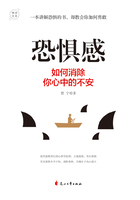第一节 抑郁个体的抑制功能
长期以来,研究者普遍接受的选择性注意机制实际上只包括兴奋机制。然而,近年来一些研究工作表明,抑制也是选择性注意的一个重要机制。选择性注意机制不仅包括目标信息的激活,也包括不相关信息的主动抑制。Hasher和Zacks(1991)指出,选择性注意的抑制机制在人类许多行为,如记忆、理解和言语产生中都起着相当重要的作用。不同的研究者对抑制有不同的理解,Bjorklund与Harnishfeger(1993)把抑制定义为一种基本的认知压抑,指阻止任务无关信息进入或保持在工作记忆中的一种加工过程,它通过阻碍激活扩散从而把注意保持在对当前任务的加工上;Hasher与Zacks的观点与此类似,认为抑制负责筛选应进入工作记忆的信息,并根据加工要求编辑工作记忆的内容,限制反应间的竞争;Neil与Westberry(1987)认为,个体在加工中首先在记忆中自动激活各种信息,然后,逐步“缩小”激活范围,最后只有那些与当前任务要求一致的表征处于激活状态,这一加工过程即选择性抑制,它是一种主动的,受意识控制的过程,发生于分心信息激活之后,并在对有关信息作出反应后结束;Dempster(1989)等以竞争性实验(如选择性注意)条件下的加工评定抑制机制,把抗干扰能力作为抑制机制效率的指标。总之,在认知理论中,一般把抑制定义为阻止无关信息进入或保持在工作记忆中,且使无关信息在总体上不损害认知加工的主动压抑过程。抑制受损将导致无关信息的激活、保持与提取,从而影响对有关信息的加工。
抑制概念对抑郁症信息加工特征具有重要的解释价值。抑郁症对负性信息的抑制障碍基于以下几个原因:首先,对注意控制的功能性磁共振(fMRI)研究发现,前扣带皮层通过背外侧前额皮层调节注意—情绪的平衡,抑制不适当情绪反应(Jukka & Lepp?nen,2006),然而,抑郁症患者在这些脑区与正常对照组相比表现为激活减弱。这可能与他们无法控制情绪干扰的注意机制有关系。其次,一些对抑郁症信息偏向的研究表明了抑制不足对信息加工的影响。Bradley(1997)的研究结果表明,抑郁个体对负性刺激的激活水平与中性刺激呈现相比并未表现出差别。然而,在对负性刺激的进一步加工过程中,抑郁个体对负性信息存在选择性偏向。该研究认为,抑郁个体不会自动朝向环境中的负性信息,但是一旦注意到负性信息,他们表现出对负性信息分离的困难性。Murphy(1996)等在情绪Go/No—Go任务下也发现抑郁症患者无法从负性信息中分离出来,认为可能与抑郁症患者无法抑制负性信息有关。最后,抑郁和过分思虑的密切相关也体现出抑郁症患者的抑制障碍。过分思虑主要指个人把注意力集中到自己的情绪状态,反复思虑,过分关注,而不是去关注如何避免这些状况的出现。对负性信息过分思虑的倾向已被认为是抑郁复发的重要因素之一,理论研究和经验性数据提示损害的抑制功能可能是过分思虑的机制之一。
在针对抑郁症的情绪抑制功能的研究中,研究者多使用颜色命名的情绪Stroop任务,在这种任务中,被试对情绪词的颜色命名的同时忽视词的语义内容,研究发现患者花费更多的时间指出与他们临床症状相关的词的颜色,认为反映了情绪刺激“争取注意资源”的程度。然而,由于任务相关信息(词的颜色)和任务无关信息(语义内容)同时呈现在相同的刺激上,因此无法区分出刺激选择和随后抑制活动的不同加工过程。因此,对stroop任务作为抑制功能的一个指标仍持争议的态度。
Tipper(2001)认为,尽管抑制是一种很难直接测量的心理过程,但是,间接的测量方法如负启动能够用来研究抑制功能。Wentura(1999)在经典负启动实验范式的基础上,考虑到目标词和干扰词的情绪效价(情绪词正性或负性)这一因素,提出情绪负启动效应(Negative Affective Priming,NAP)并进行了初步的研究,证实了正常个体存在情绪负启动效应。在负启动条件下(当前目标情绪词或图片的效价与先前干扰情绪词或图片的效价是一致的),对探测显示中目标词的反应时间比控制条件下(当前目标情绪词或图片的效价与先前干扰情绪词或图片的效价是无关的)探测显示中目标词的反应时延长时,出现情绪负启动效应。Wentura 认为,情绪负启动效应是对情绪信息抑制功能的一个有效的指标。
Joormann(2004)在此基础上,首次对抑郁程度高的学生的情绪负启动效应进行了研究,发现抑郁程度高的学生和抑郁缓解个体对负性信息反应时出现负启动效应的减弱,随后,Goeleven (2006)以情绪图片作为刺激材料,在情绪负启动实验下对住院的抑郁症患者和抑郁缓解个体进行情绪信息的抑制功能研究,发现抑郁症患者同样存在对负性信息的负启动效应减弱的现象,但抑郁缓解个体并未证实负性情绪信息的负启动效应减弱。虽然两项研究认为是抑郁个体对负性信息的抑制不足造成了负启动效应的减弱和反转,但是由于负启动效应产生两大机制(抑制机制和情节提取)一直是认知心理学中争论不休的问题,两项研究都认为结果并不能排除负启动效应后情节提取的可能性。因此,他们在对抑郁个体是否存在负性信息抑制障碍这一结论仍持慎重的态度。事实上,由于负启动效应的机制仍未明了,在负启动任务用于其他临床样本的解释上也存在这一问题。目前,对抑郁症抑制功能的研究都来自行为学水平的结果,在负启动任务中,抑郁症的抑制障碍影响了情绪信息加工的哪一些过程至今仍不清楚。近年来,负启动的理论和实验范式的发展以及负启动神经机制的研究为解决这一问题提供了新的观点。
第二节 抑制加工的指标:负启动及其神经机制
负启动效应是指当启动刺激中的干扰项成为探测刺激中的目标项时被试的反应时延长或正确率降低的现象。到目前为止,研究者们已经在不同实验材料(如字母、图片、词、数字、stroop 色词和不熟悉形状)和不同任务(如识别、计数、定位和归类等)中观察到这种负启动效应。自从20世纪80年代中期至今,负启动效应作为一种实验技术在选择性注意机制的研究中得到了广泛的应用。
关于负启动的产生机制,比较有影响的一种观点是干扰项抑制观点。这种观点认为对干扰项表征的抑制是产生负启动的原因。它认为在选择目标项的过程中产生了一个内部的模板,这个模板包含了一些将目标项区别于干扰项的知觉特征,这些特征可能是颜色、大小,也可能是位置。一个刺激输入后,将自动地引发早期的知觉加工,并与这个模板进行比较:与模板匹配的刺激将引起“是”反应,是激活的反馈;与模板不匹配的刺激则引起“否”反应,是抑制的反馈,这种抑制使后来对相同表征(探测刺激的目标项)的重新加工过程受到了损害,表现出反应的延迟,即负启动效应。事实上,Tipper等人已经把负启动效应的获得看成是人类信息加工过程中存在抑制加工成分的证据。负启动不仅被看成是注意抑制机制存在的证据,而且作为一个抑制指标激发了研究者们对认为有抑制障碍的群体的研究,如老人、儿童、精神分裂症患者、强迫障碍患者和抑郁症患者。
由于行为学数据难以说明负启动究竟和哪一种机制有关,近几年,研究者们希望从脑神经机制方面去了解负启动现象后面的机制,这一问题的解决正成为当前的研究热点。研究者认为,如果是抑制机制在起作用,则应与增强的前额叶的事件相关脑活动密切关联。Steel(2001)首次利用fMRI 在stroop实验任务下对负启动的脑机制进行了研究。研究发现,除了激活额区外,左颞区、顶下区也被广泛地激活,这种激活模式难以说明负启动现象的抑制机制。Wright(2005)则在视觉空间任务下对负启动机制作了进一步的研究,发现前额叶的几个区域都被选择性地激活,支持了抑制学说。由于抑制和提取两种解释的主要差异在于负启动效应的时程方向,抑制机制认为负启动是基于启动加工过程中由前向后抑制持续作用的结果,抑制持续更多地影响探测显示加工的早期成分,如P1,N1,P2和N2。而情节提取理论则假设负启动现象是由探测情节所触发的由后向前的记忆加工过程,注重信息加工的晚期成分,如P3或LPC。因此,研究者认为在时间上具有高分辨率的事件相关电位技术,在研究负启动的神经机制上具有独特的优势,它能够帮助我们了解在不同的负启动任务下,反应抑制加工过程的早期成分和反映刺激评价以及与记忆相关的晚期成分是否存在ERP波形的差异。
近年来对负启动的ERP研究表明,不同的负启动实验和刺激属性会影响负启动效应的 ERP指标(Kathmann et al.,2006)。Kathmann等研究发现在位置负启动实验中,负启动条件下的目标词在顶枕区的P1—N1波幅减弱,P3潜伏期延长。而在特性负启动中,额中央区的P200减弱(Gibbons,2006)。在另一项类似于皮亚杰数字任务的负启动研究中,在额中央区发现了增强的 N200 (Daurignac et al.,2006)。这些研究认为,负启动效应的抑制机制与信息加工过程相对早期的一些成分有关,如P1.N1.P2和N2,而反映认知评价阶段记忆更新过程的P3或晚正成分(Late Positive Component,LPC)在这些研究中并没有表现出差异。因此,这些研究认为负启动延长的反应时是由前向后的抑制机制所造成的。在一项分类任务的听觉负启动中(Mayr,2003),研究者发现负启动条件下探测目标出现后300ms到600ms之间顶区LPC波幅降低,由于没有在早期成分上发现支持抑制机制的ERP证据,研究者认为与情节提取有关。而另外三项认为支持情节提取观点的特性负启动中发现负启动条件下P3或LPC波幅的升高(Ceballos et al.,2003;Kathmann et al.,2006;Wagner,2006)。
笔者认为,负启动中ERP研究结果差异比较大的原因与实验刺激材料类型、数量及被试任务有很大的关系。一些研究存在刺激材料过少,探测显示中目标词的重复次数过多,在反映抑制加工的负启动任务中容易诱发被试的情节提取和重复效应,从而出现抑制机制、情节提取和重复效应混杂在一起的问题。
在该研究中,情绪负启动是以情绪词作为刺激材料的一项情绪评价任务。情绪词加工的ERP研究并不多。研究表明(Eviatar&Zaidel,1991),在情绪评价任务中,情绪效应主要体现在ERP的早期成分(如P2)和晚期成分(如N400和LPC)的变化上。并且,早期的情绪效应与中央区和顶区 P2成分的变化有很大的关系(Schapkin et al.,2000)。P2作为一个早期自动注意加工成分,是情绪信息加工过程中无意识向意识转换的一个重要成分,对负性刺激特别敏感。
LPC与情绪刺激的评价意义有关,在信息加工过程中,与快速的自动加工过程不同,认知评价在情绪的产生和调节过程中扮演了一个重要的角色。在这一阶段,个体在不同影响因素和不同情绪体验的情况下对信息进行充分分析。研究表明(Herbert et al.,2006),晚期的情绪效应更多地与LPC有关。据我们所知,至今并未有人采用ERP去研究情绪词为刺激的情绪负启动效应这一问题,因此,这一部分内容属于探索性的研究。
第三节 情绪负启动任务下抑郁抑制障碍的ERP研究
笔者发表在Psychiatry Research:Neuroimaging 182(2010)172—179上的论文
Inhibition dysfunction in depression:eventrelated potentials
during negative affective priming
Abstract
The study aims to investigate whether depressed patients show valencedependent inhibition impairment and to investigate its neurophysiological correlates using eventrelated potentials.Data collected from 18 patients with unipolar depression and18 normal controls was analyzed in a negative priming affective task.A less effective inhibition was specific for negative information and not observed for positive information in patients.Eventrelated potentials(ERPs)revealed the neurophysiological correlate of this deficit.In addition to the overall reduced P2 amplitude for negative trials and the overall reduced late positive component(LPC)amplitude for positive and negative trials in patients,the ERP differences of different conditions for each group were also found.In response to negative experimental targets,the centralparietal P2 amplitude was reduced and LPC latency was shorter in patients,whereas the left central P2 amplitude was larger and the LPC latency was delayed in controls.In response to positive experimental targets,the parietal P2 amplitude was enhanced and the LPC latency was delayed in both groups.These results suggest that the inhibition dysfunction of negative affect influences the earlier attention allocation stage and the later evaluation stage in depressed patients.
Key words:Inhibition deficit;Depression disorder;P2;LPC
1.Introduction
One aspect of cognition relevant to one's capacity to negotiate daily life is attentional inhibition,which is widely assumed to operate during selection to reduce interference from currently irrelevant items (Tipper and Baylis,1987).The concept of inhibition provides useful links between the cognitive theories of depression,general cognitive impairments,and neurological impairments.Theories from the Interactive Cognitive Subsystems model of Teasdale and Barnard(Teasdale and Barnard,1993)have proposed that depression is associated with an inability to distract attention from depressogenic information and has dysfunctional attentional control over emotional interference.Some structural brainimaging studies(Okada et al.,2003;Barch et al.,2003)suggest possible anatomical bases of the association between depression and attention control.Lowered activation was found in the dorsolateral prefrontal cortex(DLPFC)and the anterior cingulate cortex(ACC)(Rogers et al.,2004),which has been described as a neural juncture between cognition and emotion(Allman et al.,2001).
Some studies,by using the emotional Stroop task,have examined inhibitory function.These studies have found an elevated interference effect when the tobeignored word has negative emotional salience (Williams et al.,1996).However,an important argument against this task is the fact that it is difficult to differentiate the active selection of relevant information and active inhibition of irrelevant because the Stroop task requires selection of one stimulus property from within an object(Mogg and Bradley,2005).This inhibitory control,so crucial for coherent behaviour,is difficult to directly measure in normal human subjects.However,indirect measures such as negative priming can be used to study inhibition function.
Negative priming(NP),which is manifested as slower reaction time(RTs),occurs when individuals have to activate a previously inhibited distracter(compared to an unrelated condition).It provides a behavioral testimony to the effectiveness of cognitive inhibition(Houd et al.,2001).Recently,a couple of studies have adapted the classical NP paradigm to study the inefficient inhibition for negative information in depressive individuals(Goeleven et al.,2006;Jormman, 2004).In these studies,the valence of the distracter in the prime display corresponds with the valence of the probedisplay target for the experimental condition,while there is no such similarity between prime and probe for the control condition.Negative affective priming (NAP)effect,which is a slow reaction to the probe target by the previous prime distracter having the same valence,can be considered as a valid index of inhibitory function towards affective material(Wentura, 1999).Typically,depressive individuals who fail to inhibit negative information show a reduced or even reversed NAP effect on negative trials,whereas the NAP effect for positive material is unaffected(Goeleven et al.,2006;Jormman,2004).
The present evidence on the nature of inhibition deficits is limited.It has been mainly obtained from studies at the behavioral level (Gotlib et al.,2005;Koster et al.,2005).Therefore,it is still unclear which stages of emotional information processing are affected by inhibition dysfunction in depressed patients.This knowledge would be important for increasing the diagnostic specificity of depression and also for developing effective means of intervention.
Eventrelated potentials(ERPs)measures,as an electrophysiological index of cognitive information processing deficits in depressed patients(Miller,1996),have been extensively used to study brain mechanisms of cognitive functions.Only recently have researchers begun to use ERPs to study negative priming.The ERP studies on NP effect have showed that different NP tasks and stimulus modalities can influence ERP indicators of NP effects(Kathmann et al.,2006).The parietooccipital P1N1 amplitude was reduced and P3 latency was delayed in response to location NP targets(Kathmann et al.,2006).In the identity NP,the reduced frontocentral P200 was observed(Gibbons et al.,2006).In another experiment with a NP adaptation of Piagetlike numerical task,the increased frontocentral N200 was found (Daurignac,2006).These studies found that the NP effect reflecting the inhibition mechanism was related to amplitude difference of relatively early components instead of the parietal P3 or a late positive component(LPC)amplitude(Kathmann et al.,2006;Gibbons et al.,2006;Daurignac,2006),which has been interpreted as the reflection of memory updating processes of the cognitive evaluation stage(Donchin et al.,1988;Mayr,2003).Such findings support the notion that the slower behavioral speed on NP trials is caused by a forwardacting inhibition mechanism(Tipper,1985).
Different from the study of Goeleven et al.(2006),emotional words stimuli,as one of the most important means conveying emotional meaning,were used in NP task.Because P2,reflecting input processingrelated attention toward emotion stimuli(Carreti et al.,2001) and the divergence between supraliminal and subliminal affective responses(Bernat et al.,2001),is closely related to ACC(Carretie et al.,2004),which regulates the attention/emotion balance and inhibits maladaptive emotional reactions(Allman et al.,2001;Jukka et al.,2006).We specifically examined the P2stage of information processing in addition to LPC.
Due to imperfectly balanced sequence contingencies in earlier NAP studies(Goeleven et al.,2006;Joormann,2004;Wentura,1999),we added an additional filler trial in the affective modification of the NP paradigm to avoid the difference in implicit rulelearning and response bias between participants.Regarding the comparison of depressive patients with normal controls,our hypotheses were:(1)Depressive patients would show a specific failure to inhibit negative emotional words,whereas inhibition function for positive emotional words was unaffected.(2)In the ERP data depressive patients would show a modification of the inhibition effects observed in healthy subjects.
2.Materials and Methods
2.1.Subjects
Twentyone patients with unipolar major depression(DSMIV classification296.x)and 18 healthy control subjects participated in the study.Three patients had to be excluded because of an insufficient number of correct artifactfree trials.Thus,18 patients and18 control subjects were included in the final analysis.Groups were matched for gender,age and years of education(see Table 1 for demographic data).
Eighteen subjects in the depressed group were recruited from among newly admitted patients in the outpatient department of a mental hospital.None of the participants received psychotropic medication for at least 4 weeks before hospitalization.Diagnosis was confirmed by Structured Clinical Interviews for DSMIV(Spitzer et al.,1995). All patients with a history of an AxisI disorder other than unipolar depression were excluded from the study.Eighteen participants in control group were selected from those who had responded to an advertisement posted in Central South university.They had no history of major medical or psychiatric illness and were on no medication.All the participants were right handed and had normal or correctedtonormal eyesight.No participants had a history of red/green color blindness.
To obtain an estimate of the severity of the depression,the 17item version of the Hamilton Depression Rating Scale(HDRS;Hamilton,1967)and the Beck Depression Inventory(BDI;Beck et al.,1961)were completed on the day of the ERP recordings.Patients were required to have a score of17 points or over on the HDRS,while controls had to score less than7 points for inclusion(see Table1).
The ethics committee of Central South University approved the study,and all subjects gave written informed consent.
2.2.Stimuli
A total of400 Chinese words,including160 positive,160 negative and80 filler emotion words,all composed of two characters,were used in the study.Forty participants including 18 males and 22 females(who were not participants of the ERP experiment)rated these words based on a9point scale before the experiment.A ttest showed that there was no significant difference for positive and negative words in the frequency of words(6.630.63 vs.6.69 0.59,respectively;t159=0.98,P =0.328),imageability(6.400.50vs.6.41 0.35,respectively;t159=0.30,P =0.764),affective extremity (6.430.37 vs.6.490.44,respectively;t159=1.05,P =0. 30)and the number of strokes of the characters constituting the words (P =0.789)across all the trial types.Positive and negative words differed significantly on the valence dimension(6.910.41vs.2.52 0.42,respectively;t159=933.70,P <0.001).For filler emotion words,only valence dimension was evaluated,and positive and negative words differed significantly(7.02 0.35 vs.2.63 0.32,respectively;t39=644.05,P<0.001).
The trial consisted of a prime display and a probe display,each of which contained a target word and a distracter word.The two words with a Song'font appeared on a black background in the center of the screen.Each word had a visual angle of approximately 1.15o vertical,2.33o horizontal.The two vertically arranged prime stimuli had a visual angle of2.76o in height.
2.3.The NAP paradigm and procedure
The experimental paradigm adapted from an affective modification of the negative priming task(Joormann,2004)allows analysis of negative priming for positive and negative words separately.Two basic types of primeprobe trials defined the experimental conditions:In negative priming trials,the valence of the prime distracter word is identical with that of the probe target.In control trials,the valence of the prime distracter word is different from that of the probe target.Additional filler trials were included in which the target valence of prime and probe was identical.The sequence of the experiment consists of 200 trials(40 positive experimental trials,40 positive control trials,40 negative experimental trials,40 negative control trials,40 filler trials).The order of presentation of5blocks and the order of trials within each block were pseudorandomized.The response cue(red or green color)was counterbalanced between subjects.Each word was used only once as a distracter or target and only once in a prime and a probe display.
Participants were seated in an electrically isolated,soundand lightattenuated room.A computer monitor was placed1 m in front of the participant's eyes.
The paradigm is illustrated in Fig.1.A cross introduced each trial and remained on the screen until the participant pressed the appropriate button(The use of this step allowed participants to pace themselves for reducing error rates,especially for depressed patients). When the button was pressed,the screen went blank for700 ms,then the prime appeared for1000 ms.The prime was followed by a blank screen for500 ms.After this blank interval,the probe was delivered for1000ms.The participants were told that in the upper and the lower half of the computer screen a pair of words would appear:one word with a red color,the other with a green color.They were asked to evaluate the valence of the target word indicated by the color of the words by pressing a corresponding key while they were asked to ignore the distracter word.Stimulus presentation and recording of reactions were performed with the STIM system(Neuroscan,program GENTASK,Version 2.0).Speed and accuracy were emphasized in the instructions.To reduce false classifications of words,20 practice trials were presented preceding the main experiment.
2.4.Electroencephalogram(EEG)recordings and analysis
EEG data was recorded from 32 scalp electrodes using tin electrodes mounted in an elastic cap(NeuroScan Inc.,USA).All electrodes were referenced to the left and right mastoids.Vertical electrooculogram(EOG)recording electrodes were positioned above and below the left eye,and horizontal EOGrecording electrodes were positioned at the outer canthi of both eyes.Electrode impedances were below5 kΩ.Recording bandwidth ranged from DC to70 Hz .The EEG and EOG were sampled at a digitization rate of500 Hz/channel with a NuAmps amplifier(Neuroscan Inc.USA).
Neuroscan analysis software(Scan4.3,NeuroScan Inc.,USA) was used to analyze EEG data offline.Trials with artifacts were rejected,with a criterion of ±80 μV.The EEG data were segmented according to the word onset in each trial(100 -1000 ms epoch length),filtered(0.01 -30 Hz,-24 dB cutoffs),and baseline corrected(-100-0 ms).
The following sites were chosen for statistical analysis:frontal (F3,Fz,F4),central(C3,Cz,C4),and parietal sites(P3,Pz, P4).Based on the grand-averages ERPs displayed in Fig.2.Mean amplitudes of P2and LPC were measured in the140-280ms and400-700 ms time window respectively.LPC Peak latencies were measured by using the onset stimulus as the time reference.Peak latencies and mean amplitudes were calculated in each condition for each participant of each group.Only ERPs recorded during correct responses to probe targets were analyzed.Repeatedmeasures analyses of variance were conducted separately for each of the dependent variables,with the betweensubjects factor of group(depressed patients vs.control subjects)and three withinsubjects factors:condition(experimental vs.control),gradient(frontal,central,parietal electrode position) and laterality(left,midline,right electrode position).
2.5.Statistical analysis
Values are quoted as means standard deviations.Statistical comparisons were made using twotailed ttests reporting t values.The Greenhouse-Geisser correction was used when appropriate.A level of p <0.05 was accepted as statistically significant.
3.Results
3.1.Group characteristics















